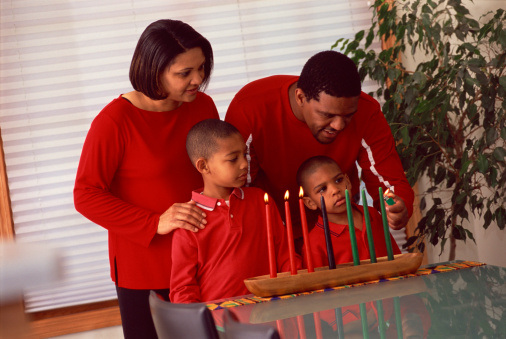
A number of African Americans of a certain age wonder about the validity of the week-long celebration and question whether it is a legitimate holiday, citing that it was first celebrated in 1966 and has its roots in the black nationalist movement of the 1960s rather than Biblical or religious tradition. The holiday’s creator, Maulana Karenga intended to “give blacks an alternative to the existing holiday [Christmas] and give blacks an opportunity to celebrate themselves and their history, rather than simply imitate the practice of the dominant society.”
But, what’s wrong the practice of the dominant society which is Christian based, and do we as black people have to choose between the two? Not hardly. As Kwanzaa grew in popularity, its creator modified his position to avoid alienating practicing Christians, stating that “Kwanzaa was not created to give people an alternative to their own religious holiday.”
Approximately five percent of African Americans celebrate Kwanzaa with its popularity leveling off as the black power movement continues to wane, although several white institutions recognize and celebrate the holiday now.
Jessica Smith of Culture Kingdom Kids discussed the true meaning of the holiday on “NewsOne Now,” and broke down the symbolism behind the kinara candles, corn, and the unity cup.
And, yes, you can give gifts, too. The primary objective is to buy black-owned or try DIY. “The purpose of that is the focuses of Kwanzaa are heritage and education… and economics,” Smith said, “so you want to support a black company… For Kwanzaa you can give a book on African American heritage so they’re building their library that way, or you can make a gift.”
The seven principles of Kwanzaa, or Nguzo Saba represent “the best of African thought and practice in constant exchange with the world,” according to Karenga.
Each of the seven days of Kwanzaa is dedicated to one of the following principles:
- Umoja (Unity): To strive for and to maintain unity in the family, community, nation, and race.
- Kujichagulia (Self-Determination): To define ourselves, name ourselves, create for ourselves, and speak for ourselves.
- Ujima (Collective Work and Responsibility): To build and maintain our community together and make our brothers’ and sisters’ problems our problems, and to solve them together.
- Ujamaa (Cooperative Economics): To build and maintain our own stores, shops, and other businesses and to profit from them together.
- Nia (Purpose): To make our collective vocation the building and developing of our community in order to restore our people to their traditional greatness.
- Kuumba (Creativity): To do always as much as we can, in the way we can, in order to leave our community more beautiful and beneficial than we inherited it.
- Imani (Faith): To believe with all our hearts in our people, our parents, our teachers, our leaders, and the righteousness and victory of our struggle.
Kwanzaa symbols include a decorative mat (Mkeka) on which other symbols are placed, corn (Muhindi) and other crops, a candle holder kinara with seven candles (Mishumaa Saba), a communal cup for pouring libation (Kikimbe cha Umoja), gifts (Zawadi), a poster of the seven principles, and a black, red, and green flag. The symbols were designed to convey the seven principles.